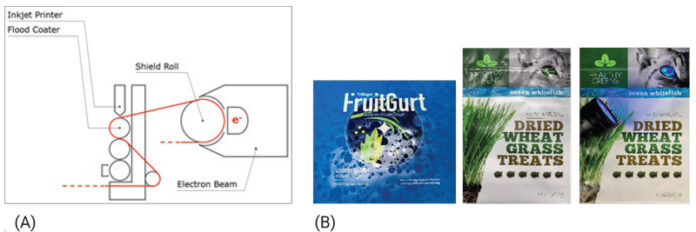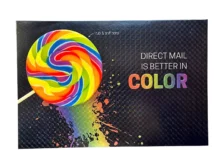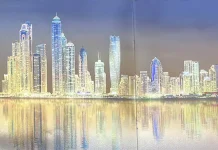By Sage M. Schissel, Ph.D., PCT Ebeam and Integration, LLC
From glitz and glam to texture and realism, embellishment can provide an added layer of pizzaz to any package. When competition for the consumer’s attention has never been so fierce, embellishment can be the differentiator that makes a package fly off the shelf – figuratively speaking, that is. Embellishment has not quite yet risen to the level of magic, though what some producers have created is nothing short of remarkable!1 Whether it be Cast and Cure™, cold foil transfer or spot embellishments, often these techniques are achieved with UV, but did you know that they also can be accomplished with electron beam (EB)?
A popular embellishment, Cast and Cure™, uses a specialty film to emboss a pattern into an overprint varnish (OPV).2 The film is temporarily laminated to the OPV while still wet, allowing the surface of the OPV to conform to the features of the film. Then, the OPV is polymerized with EB, freezing the pattern into the coating. Finally, the film is removed and rewound separately for future use. Using Cast and Cure™ in combination with EB brings a holographic ‘wow’ to photoinitiator-free, indirect-food-contact-safe, EB-curable OPVs. According to Tim Cain, president of Breit Technologies LLC, “We think there are significant opportunities to expand Cast and Cure™ within the EB market. We have had success with the food markets, and this is an area that could see a great deal of expansion.”
Need a metallic finish? Cold foil transfer is the process of transferring a metallic foil from a carrier web to the packaging substrate.3 A laminating adhesive is applied to the substrate and the foil nipped to the adhesive. The system is exposed to the beam, polymerizing the adhesive and adhering the foil, and finally, the carrier web (with any remaining foil) is removed and rewound separately. Since EB has no trouble penetrating through the opaque foil, the adhesive does not need to be activated prior to being nipped to the foil. The location of both Cast and Cure™ and cold foil transfer embellishments can be controlled by selective placement of the OPV or laminating adhesive, respectively.
The equipment requirements for both types of embellishment are identical. Both require a secondary unwind and rewind for the addition and removal of the embossing film or foil carrier web. Moreover, a laminating nip is required before the beam entrance, and another adjustable web-guiding roll is needed after exiting the beam to ensure the proper release angle of the secondary web. Any ebeam line with these capabilities is, by default, also capable of laminating and curing coatings (or inks), and thus considered a 4-in-1 line. To accommodate the thickness of the secondary web, the maximum accelerating voltage of the EB is generally 150 kV.4 Since nitrogen inerting is only required for coatings, the beam also can be set up for both inerting and ozone exhaust.5
Want an embellishment that can be both visual and tactile? Spot embellishment might be the solution. This broad term encompasses multiple methods to achieve the selective placement of coating or ink. The embellishment can be applied with a patterned flexo plate, or digital inkjet heads can be used so that the embellishment can be changed frame by frame to match a digital print. Figure 1 shows an example of the latter method; indirect gravure was used to flood coat the HP Indigo-printed substrate with a matte OPV, then clear gloss inkjet ink was patterned over top in a wet-on-wet process.

The contrast of the gloss between the embellishment and the flood coat is visually appealing, but also it resulted in a tactile effect from the contrasting coefficients of friction and the additional coat weight of the embellishment. Furthermore, the ink used in this example naturally fluoresces under blacklight, providing more creative opportunities. Voltage requirements vary depending on the thickness of the embellishment but most often fall between 100 and 125 kV for packaging applications.
When considering whether to use UV or EB for an embellishment application, it is helpful to review a few key aspects of the two technologies. Both UV and EB can be used to apply embellishments on a variety of substrates for a variety of different applications; however, the fact that EB doesn’t need an initiator gives the technology an advantage when used in sensitive applications, such as pharmaceutical or food packaging. No photoinitiator in the formulation eliminates any worry of photoinitiator-fragment migration.
Elizabeth Leeper, technical developer at Daybreak Technologies, said, “The photoinitiator (PI) package has to be carefully curated around the application. Different PIs absorb light at different wavelengths, and certain films, like those used for cold foil, can block portions of the UV spectrum. Also, by weight, PIs typically are the costliest component of any UV or UV-LED formulation.”
Another difference between EB and UV is the mechanism that governs depth of cure.4 “In UV, the bulb’s spectral output coupled with the PI’s screening of the light makes for cure gradients. This can result in poor adhesion properties,” according to Leeper. Attention must be given to UV lamps as the bulbs decay over time and reflectors become dirty, since these factors influence the spectral output.
In contrast, the filaments that produce the electrons for EB equipment either function or don’t; there is no degradation in the interim. Electrons also are not influenced by optical clarity; rather, the depth of cure is determined by material density of the coating/film and the accelerating voltage (kV) of the machine. Monte Carlo simulations can be used to determine a voltage that avoids cure gradients. Additionally, working with color-blind electrons means more flexibility when it comes to embellishing with richly pigmented and/or metallic inks and coatings.
An area where UV technology excels in comparison to EB is cost. Historically, UV has been much less expensive than EB, providing new adopters a low barrier into the market, and, over time, establishing a broader base of users. Today, EB only makes up a small fraction of the radiation curing market. However, progress has been made in the last 15 years by efficiently scaling EB to the application. With the availability of units specifically designed with maximum voltages of 100 to 150 kV, there’s significant cost savings (and reduction in footprint) in comparison to the original low-energy electron beams, which can handle accelerating voltages up to 300 kV. Furthermore, as demand increases for faster line speeds and wider webs, the cost differences between UV and EB diminish. Where UV generally requires additional lamps as line speed increases, a single EB can accommodate line speeds up to 1,300 ft/min (400 m/min).
In summary, consider the advantages of EB the next time a package calls for embellishment! Whether it’s Cast and Cure™, cold foil transfer, spot embellishment or maybe even a new embellishment technique, EB can help push the bounds of possibility.
References:
- 2021. FSEA Gold Leaf Awards Celebrate UV Curing. UV+EB Tech. (3).
- DeDonder, M., 2015. Cast and Cure: A Game-Changing Decorative Application Process. UV+EB Tech. (3).
- Embellishments: foil stamping process. https://www.labelsandlabeling.com/label-academy/article/embellishments-foil-stamping-processes
- Schissel, S., 2021. EB Operation 101. UV+EB Tech. (1).
- Schissel, S., 2021. Comparing EB and UV: Common Questions. UV+EB Tech. (2).





